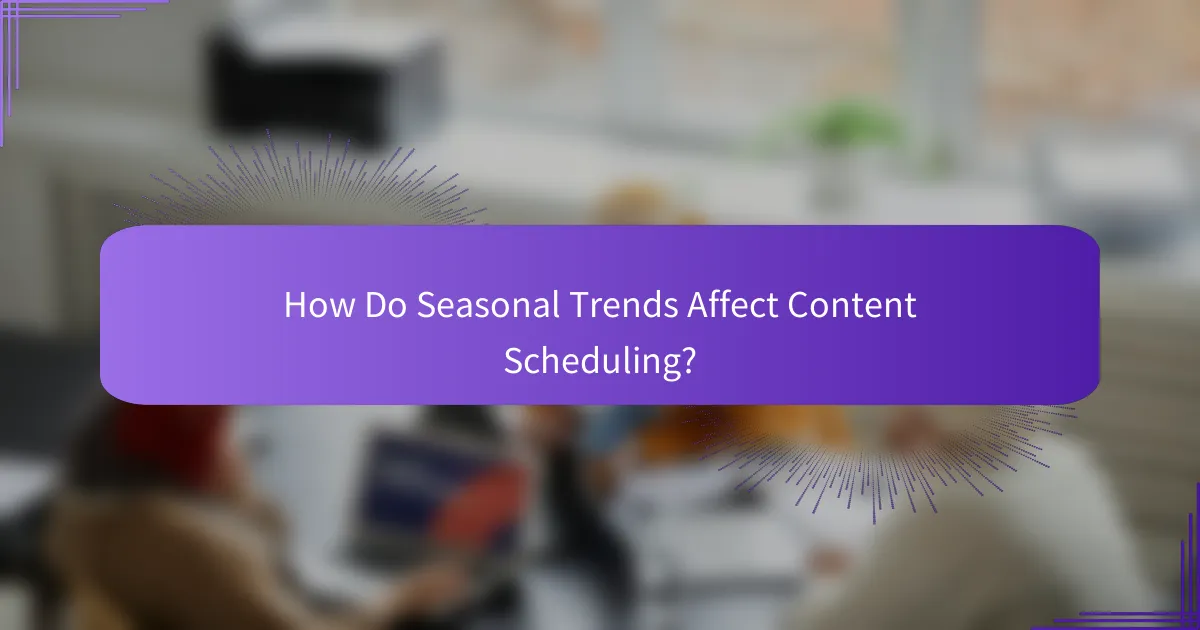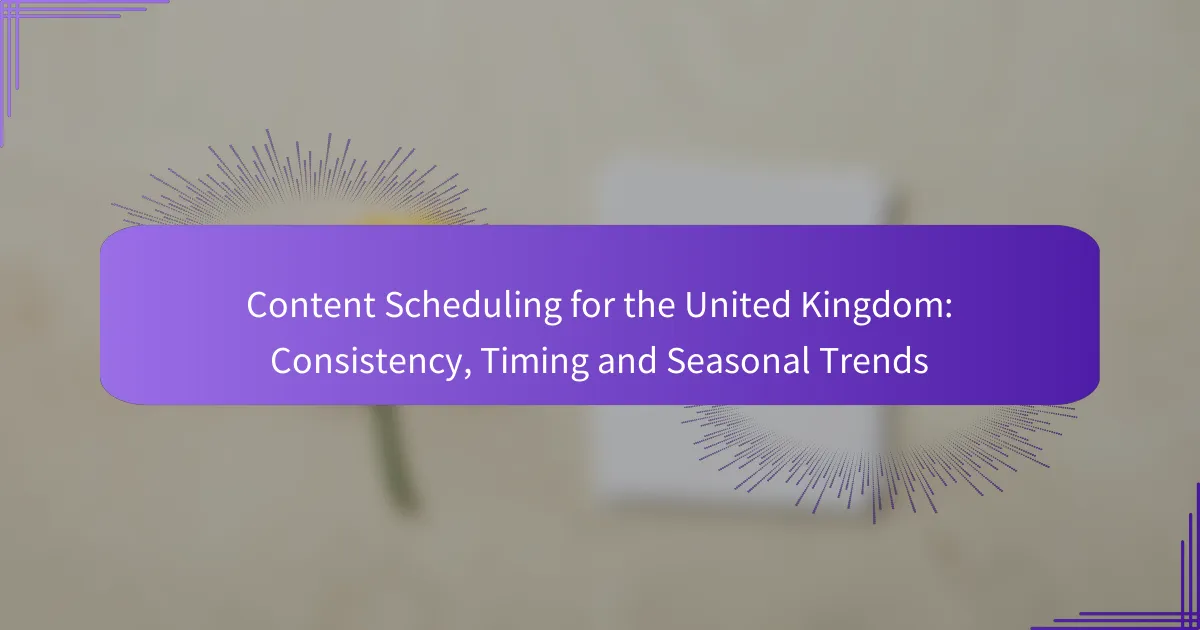Effective content scheduling in the United Kingdom hinges on consistency, timing, and an awareness of seasonal trends. By strategically planning when to post, marketers can boost audience engagement and align their efforts with broader marketing goals. Recognising peak engagement times and adapting to seasonal shifts can significantly enhance visibility and interaction with content.

How to Schedule Content Effectively in the United Kingdom?
To schedule content effectively in the United Kingdom, focus on consistency, timing, and seasonal trends. A well-planned schedule can enhance audience engagement and align with marketing strategies.
Use a Content Calendar
A content calendar is essential for organising and visualising your content schedule. It allows you to plan ahead, ensuring that you maintain a consistent posting frequency across various platforms.
When creating a content calendar, consider including key dates such as holidays, industry events, and product launches. This helps you align your content with relevant themes and trends that resonate with your audience.
Leverage Scheduling Tools
Scheduling tools can automate the posting process, saving you time and ensuring your content goes live at optimal times. Popular tools like Hootsuite, Buffer, or CoSchedule allow you to manage multiple platforms from a single interface.
Choose a tool that fits your needs and budget. Many offer free trials or tiered pricing based on features, so you can find one that scales with your content strategy.
Set Clear Deadlines
Establishing clear deadlines for content creation and publication is crucial for maintaining a steady flow of material. Deadlines help keep your team accountable and ensure that content is produced in a timely manner.
Consider setting internal deadlines that are a few days before the actual publication date. This buffer allows for revisions and unexpected delays, ensuring that your content is polished and ready for your audience.
Align with Marketing Goals
Your content schedule should directly support your overall marketing goals. Whether you aim to increase brand awareness, drive traffic, or generate leads, your content should reflect these objectives.
Regularly review your content performance metrics to ensure alignment with your goals. Adjust your schedule based on what types of content perform best, and be flexible to adapt to changing market conditions or audience preferences.

What Are the Best Times to Post Content in the UK?
The best times to post content in the UK depend on audience behaviour, platform algorithms, and seasonal trends. Generally, targeting peak engagement hours and specific days can significantly enhance visibility and interaction.
Peak Engagement Hours
Peak engagement hours typically fall between late mornings and early afternoons, specifically from 10 AM to 2 PM. During these hours, users are most active on social media and other platforms, leading to higher interaction rates.
Consider experimenting with posting at 11 AM or 1 PM, as these times often yield better results. However, the optimal hours can vary by platform; for instance, Instagram might see more activity in the evenings compared to LinkedIn, which is more active during business hours.
Day of the Week Insights
Engagement levels fluctuate throughout the week, with mid-week days like Wednesday and Thursday generally performing better for most content types. Mondays can be slow as users catch up on work, while Fridays often see a drop-off as people shift focus to the weekend.
For B2B content, weekdays are preferable, while B2C content may perform well on weekends when users have more leisure time. Tailoring your posting schedule to these patterns can improve overall engagement.
Seasonal Timing Considerations
Seasonal trends significantly impact content performance, with certain times of the year driving more traffic. For example, holiday seasons like Christmas often see increased online activity, making them ideal for promotional content.
Additionally, consider industry-specific seasons; for instance, tax-related content should be prioritised in early spring. Monitoring these trends can help you align your content strategy with audience interests throughout the year.

How Do Seasonal Trends Affect Content Scheduling?
Seasonal trends significantly impact content scheduling by influencing audience engagement and preferences throughout the year. Understanding these trends helps marketers align their content strategies with consumer behaviour, ensuring timely and relevant messaging.
Identify Key Holidays
Recognising key holidays is essential for effective content scheduling. Major holidays like Christmas and Easter often see increased online activity, making them prime opportunities for targeted content. Additionally, consider less prominent holidays that may resonate with niche audiences, such as National Pet Day or Earth Day.
Mark your calendar with these dates and plan content around them to maximise engagement. For instance, create themed promotions or special blog posts that align with holiday sentiments.
Adapt Content for Seasonal Themes
Adapting content to reflect seasonal themes enhances relevance and connection with your audience. For example, summer content might focus on outdoor activities and travel, while winter content could emphasise holiday shopping and cosy indoor experiences. Tailoring your messaging to fit these seasonal contexts can lead to higher engagement rates.
Utilise seasonal imagery, language, and topics that resonate with the time of year. This approach not only attracts attention but also fosters a sense of community and shared experience among your audience.
Analyse Seasonal Audience Behaviour
Understanding seasonal audience behaviour is crucial for optimising content scheduling. Analyse past performance data to identify trends in audience engagement during different times of the year. Look for patterns in website traffic, social media interactions, and conversion rates to inform your future strategies.
Consider using tools like Google Analytics to track seasonal spikes in traffic and engagement. This data can guide your content calendar, helping you to schedule posts when your audience is most active and receptive.

What Tools Can Help with Content Scheduling?
Effective content scheduling in the United Kingdom can be streamlined using various tools designed for different aspects of content management. These tools help ensure consistency, optimise timing, and align with seasonal trends, making it easier to maintain a steady flow of content.
Buffer for Social Media Management
Buffer is a popular tool for scheduling social media posts across multiple platforms. It allows users to plan, publish, and analyse their content, making it easier to maintain a consistent posting schedule. With Buffer, you can set specific times for your posts to go live, which helps in reaching your audience when they are most active.
To maximise Buffer’s effectiveness, consider creating a content calendar that aligns with your audience’s engagement patterns. Regularly analyse performance metrics to adjust your posting times and content types based on what resonates best with your followers.
Trello for Project Management
Trello is a versatile project management tool that can be effectively used for content scheduling. It utilises boards, lists, and cards to help you visualise your content workflow, from ideation to publication. This visual approach makes it easy to track deadlines and responsibilities among team members.
For optimal use, create a dedicated board for your content calendar, categorising cards by content type or publication date. Regularly update the status of each card to reflect progress, and utilise Trello’s integration features to connect with other tools you may be using for a seamless workflow.
CoSchedule for Marketing Integration
CoSchedule is an all-in-one marketing calendar that integrates content scheduling with marketing efforts. It allows you to plan, publish, and promote your content while ensuring that all marketing activities are aligned. This tool is particularly useful for teams looking to synchronise their content strategy with broader marketing campaigns.
To leverage CoSchedule effectively, take advantage of its analytics features to track the performance of your content across different channels. This data can inform future scheduling decisions, helping you to capitalise on seasonal trends and optimise your content for maximum impact.

What Criteria Should You Consider When Choosing a Scheduling Tool?
When selecting a scheduling tool, focus on ease of use, integration capabilities, and features that align with your content strategy. A good tool should simplify the scheduling process while allowing for flexibility and adaptability to seasonal trends.
Ease of Use
Ease of use is crucial when choosing a scheduling tool, as it directly impacts your team’s efficiency. Look for intuitive interfaces that require minimal training and allow users to quickly navigate through features.
Consider tools that offer drag-and-drop functionality for scheduling posts, as this can significantly reduce the time spent on planning. A user-friendly dashboard that provides a clear overview of upcoming content can also enhance productivity.
Before committing, take advantage of free trials to assess how easily your team can adapt to the tool. Avoid tools that are overly complicated or require extensive setup, as these can lead to frustration and decreased consistency in your content scheduling.
